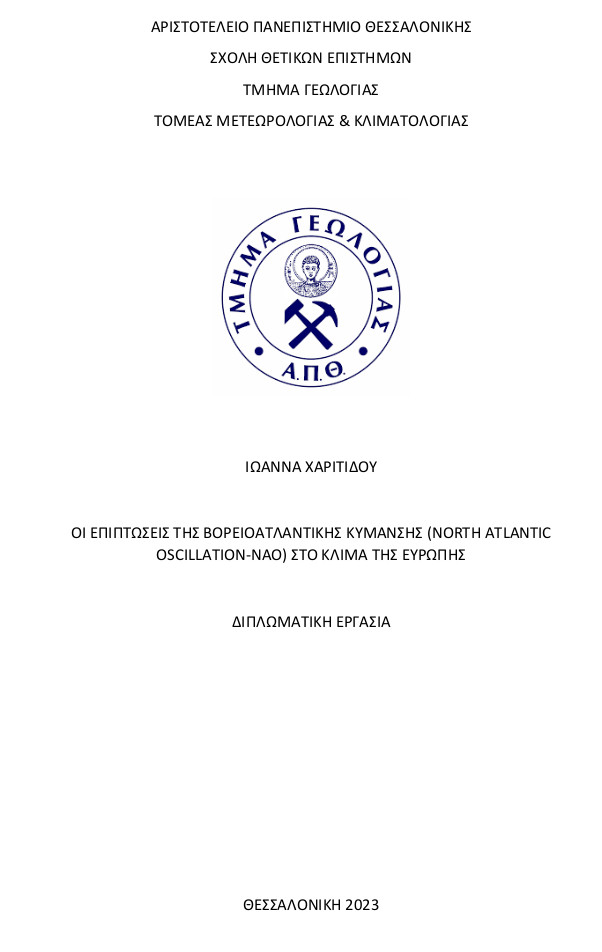
Η επιπτώσεις της βορειοατλαντικής κύμανσης (North Atlantic Oscillation-NAO) στο κλίμα της Ευρώπης = The impact of the North Atlantic Oscillation-NAO in the climate of Europe.
Περίληψη
The aim of this study is to investigate the influence of the North Atlantic Oscillation (NAO) on the climate of Europe, with the ultimate goal of monitoring the variation of winds, temperature and precipitation. First, the climate of Europe is discussed and then the atmospheric teleconnection and, more extensively, the North Atlantic Oscillation is analyzed. Then, for the purpose of this study, 73 years of data (1/1/1950 - 2/26/2023) were collected from the National Oceanic and Atmospheric Administration. For days when the NAO was at an extreme value, maps of mean temperature and temperature anomalies, maps of daily precipitation and precipitation anomalies and maps of airflow movement in Europe were drawn. The results confirm that during the negative phase of the NAO, higher temperatures are observed in Southern Europe and lower in Northern Europe, while during the positive phase of the NAO, higher temperatures are observed in Southern Europe and lower in Northern Europe. Furthermore, it is found that during the negative phase of the NAO, precipitation increases in Southern Europe and decreases in Northern Europe, while during the positive phase of the NAO, it increases in Northern Europe and decreases in Southern Europe.
Πλήρες Κείμενο:
PDFΑναφορές
Benedict, J. J., Lee, S., & Feldstein, S. B. (2004). Synoptic view of the North Atlantic oscillation. Journal of the Atmospheric Sciences, 61(2), 121-144.
Bolle, H. J. (Ed.). (2003). Mediterranean climate: variability and trends. Springer Science & Business Media.
Géron, C., Lembrechts, J. J., Borgelt, J., Lenoir, J., Hamdi, R., Mahy, G & Monty, A. (2021). Urban alien plants in temperate oceanic regions of Europe originate from warmer native ranges. Biological Invasions, 23(6), 1765-1779.
Gillett, N. P., Graf, H. F., & Osborn, T. J. (2003). Climate change and the North Atlantic oscillation. Geophysical Monograph-American Geophysical Union, 134, 193-210.
Horel, J. D. (1981). A rotated principal component analysis of the interannual variability of the Northern Hemisphere 500 mb height field. Monthly Weather Review, 109(10), 2080-2092.
Hurrell, J. W., & Deser, C. (2010). North Atlantic climate variability: the role of the North Atlantic Oscillation. Journal of marine systems, 79(3-4), 231-244.
Hurrell, J. W., Kushnir, Y., Ottersen, G., & Visbeck, M. (2008, June). The North Atlantic Oscillation: climatic significance and environmental impact. In AGU Fall Meeting Abstracts (Vol. 134, p. 1244).
Kushnir, Y., & Wallace, J. M. (1989). Low-frequency variability in the Northern Hemisphere winter: Geographical distribution, structure and time-scale dependence. Journal of the Atmospheric Sciences, 46(20), 3122-3143.
Nigam, S., & Baxter, S. (2015). Teleconnections. Encyclopedia of Atmospheric Sciences, G. North, Ed. Elsevier Science, 90, 109.
Pausas, J. G., & Millán, M. M. (2019). Greening and browning in a climate change hotspot: the Mediterranean Basin. BioScience, 69(2), 143-151.
Robertson, A. W., Mechoso, C. R., & Kim, Y. J. (2000). The influence of Atlantic sea surface temperature anomalies on the North Atlantic Oscillation. Journal of Climate, 13(1), 122-138.
Scaife, A. A., Folland, C. K., Alexander, L. V., Moberg, A., & Knight, J. R. (2008).
European climate extremes and the North Atlantic Oscillation. Journal of Climate, 21(1), 72-83.
Stephenson, D. B., Wanner, H., Bronnimann, S., & Luterbacher, J. (2003). The history of scientific research on the North Atlantic Oscillation. Geophysical monograph-American Geophysical Union, 134, 37-50.
Feldstein, S. B., & Franzke, C. L. (2017). Atmospheric teleconnection patterns. Nonlinear and stochastic climate dynamics, 54-104.
Trigo, R. M., Osborn, T. J., & Corte-Real, J. M. (2002). The North Atlantic Oscillation influence on Europe: climate impacts and associated physical mechanisms. Climate research, 20(1), 9-17.
Visbeck, M. H., Hurrell, J. W., Polvani, L., & Cullen, H. M. (2001). The North Atlantic Oscillation: past, present, and future. Proceedings of the National Academy of Sciences, 98(23), 12876-12877.
Wallace, J. M., & Gutzler, D. S. (1981). Teleconnections in the geopotential height field during the Northern Hemisphere winter. Monthly weather review, 109(4), 784-812.
Κερασιλίδου, Μ. Π. (2020). Η επίδραση της Madden-Julian κύμανσης (MJO) στο κλίμα της Ευρώπης= The impact of Madden-Julian oscillation (MJO) on the European climate. Προ/Μεταπτυχιακές Διατριβές στη Βιβλιοθήκη Θεόφραστος του Τμήματος Γεωλογίας του ΑΠΘ.
Εισερχόμενη Αναφορά
- Δεν υπάρχουν προς το παρόν εισερχόμενες αναφορές.
